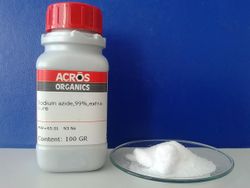Sodium azide
 Sodium azide sample
| |
| Names | |
|---|---|
| IUPAC name
Sodium azide
| |
| Systematic IUPAC name
Sodium azide | |
| Other names
Azium
Sodium trinitride Smite | |
| Identifiers | |
| Jmol-3D images | Image |
| |
| Properties | |
| NaN3 | |
| Molar mass | 65.0099 g/mol |
| Appearance | White solid |
| Odor | Odorless |
| Density | 1.846 g/cm3 (20 °C) |
| Melting point | 275 °C (527 °F; 548 K) (violent decomposition) |
| Boiling point | Violent decomposition |
| 38.9 g/100 mL (0 °C) 40.8 g/100 mL (20 °C) 55.3 g/100 mL (100 °C) | |
| Solubility | Very soluble in anhydrous ammonia Slightly soluble in benzene Insoluble in acetone, chloroform, diethyl ether, hexane, toluene |
| Solubility in methanol | 2.48 g/100 mL (25 °C) |
| Solubility in ethanol | 0.22 g/100 mL (0 °C) |
| Acidity (pKa) | 4.8 |
| Thermochemistry | |
| Std molar
entropy (S |
70.5 J/mol K |
| Std enthalpy of
formation (ΔfH |
21.3 kJ/mol |
| Hazards | |
| Safety data sheet | ScienceLab |
| Flash point | 300 °C |
| Lethal dose or concentration (LD, LC): | |
| LD50 (Median dose)
|
27 mg/kg (oral, rats/mice) |
| Except where otherwise noted, data are given for materials in their standard state (at 25 °C [77 °F], 100 kPa). | |
| Infobox references | |
Sodium azide is a sodium salt with the chemical formula NaN3.
Contents
Properties
Chemical
Sodium azide will decompose at temperatures over 300°C to yield nitrogen gas.
- 2 NaN3 → 2Na + 3 N2
In contact with a strong acid will release hydrazoic acid.
- NaN3 + H+ → HN3 + Na+
Sodium azide can be destroyed by reacting it with nitrous acid
- 2 NaN3 + 2 HNO2 → 3 N2 + 2 NO + 2 NaOH
Physical
Sodium azide is a white odorless salt. Sodium azide is soluble in water (40.8 g/100 mL at 20 °C) and ammonia, but insoluble in acetone, ether, chloroform and hexane.
Availability
Sodium azide was used in the first car airbags, as the gas generator. It is usually mixed with either silica and iron(III) oxide so purification is required.
Preparation
Industrially sodium azide is prepared via "Wislicenus process", by reacting sodium amide with nitrous oxide. Sodium amide is prepared by reacting metallic sodium with anhydrous ammonia.
- 2 Na + 2 NH3 → 2 NaNH2 + H2
- 2 NaNH2 + N2O → NaN3 + NaOH + NH3
As this method uses metallic sodium and inert conditions it is expensive for the amateur chemist.
A less complex synthesis involves the reaction of a nitrite ester with hydrazine:
- R-ONO + N2H4 + NaOH → NaN3 + R-OH + 2 H2O
Another method discussed involves the reaction of sodium nitrite with urea under controlled conditions.
Projects
- Generating pure nitrogen gas
- Preparation of pure sodium
Handling
Safety
Sodium azide is extremely toxic. The toxicity of azides is similar that of cyanides, the lethal dose for an adult human is around 0.7 g.
Storage
Sodium azide should be stored in spark-free containers, away from moisture or any acidic vapors.
Disposal
When disposed of, it must never be poured down the drain, as it will react to either copper or lead plumbing to yield hydrazoic acid. Hydrolysis can also occur in aqueous solutions, at certain pH. Sodium azide must be treated with nitrous acid before being discarded.[1] Sodium nitrite can also be used.
References
Relevant Sciencemadness threads
- Chemical pages without CAS Registry Number
- Articles without EBI source
- Chemical pages without ChemSpiderID
- Chemical pages without DrugBank identifier
- Articles without KEGG source
- Articles without InChI source
- Articles without UNII source
- Articles containing unverified chemical infoboxes
- Chemical compounds
- Inorganic compounds
- Sodium compounds
- Azides
- Energetic materials
- Things that can kill you very quickly